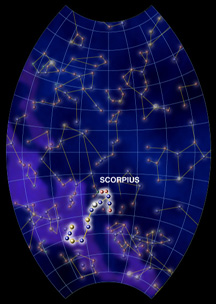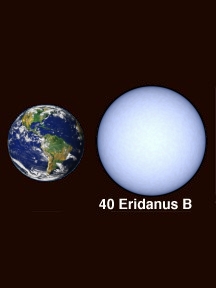The Constellation Lyra, the Harp
Click on image for full size
Lyra
It seems the sky is filled with mythical people and animals. But now
meet the one and only musical instrument to grace the sky: Lyra, the
Lyre! A lyre is a small harp, small enough to fit in your lap. The
brightest star in Lyra, Vega, is
placed in the handle of the harp. A small rectangle of four
faint stars outline the harp itself.
Vega is a very bright star (the fifth brightest in the whole sky) and
is very close. Lyra is also home to one of the brightest, loveliest planetary nebulae, the
Ring Nebula.
The stories that we have from ancient Greece tell us that the lyre was
invented by Hermes as a child by placing strings on a shell.
He traded the lyre to Apollo, who then gave it to his son, Orpheus, a
great musician.
The Lyrid meteor shower happens in April each year. The meteors in the Lyrid meteor shower seem to shoot outward from the constellation Lyra.
You might also be interested in:

How did life evolve on Earth? The answer to this question can help us understand our past and prepare for our future. Although evolution provides credible and reliable answers, polls show that many people turn away from science, seeking other explanations with which they are more comfortable.
...more
Cygnus, the Swan, looks like a big cross. The tail of the swan is marked by the bright star Deneb. The head of the swan is a star called Albireo, a star with a surprise! Three fainter stars cross the line
...more
Aquila, the Eagle, is one of many beautiful birds in the night sky. (Can you name all the others? There are 6 more "real" birds and one mythical bird!) A straight line of three stars is part of the wings
...more
Hercules was a great warrior in Greek mythology. From the northern hemisphere he can be seen kneeling in the sky during Spring. From the southern hemisphere, he appears low in the north. Four bright stars
...more
It seems the sky is filled with mythical people and animals. But now meet the one and only musical instrument to grace the sky: Lyra, the Lyre! A lyre is a small harp, small enough to fit in your lap.
...more
Sagittarius is a make-believe creature with the chest and head of a man and the body and legs of a horse. He is shooting his bow at the Scorpion, just next door. Sagittarius is big, but his stars are not
...more
Some constellations do not really look like their names. It takes a lot of imagination to picture the stars of Pegasus as a winged horse, for example. But Scorpius really looks like a scorpion! It has
...more
What's in a Name: Star designated 40 in the constellation Eridanus. Claim to Fame: One of the first white dwarfs found. A white dwarf is the exposed extremely hot core of a star that has blown off its
...more














